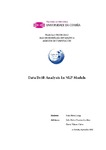Data Drift Analysis In NLP Models

Ver/
Use este enlace para citar
http://hdl.handle.net/2183/34026Coleccións
Metadatos
Mostrar o rexistro completo do ítemTítulo
Data Drift Analysis In NLP ModelsAutor(es)
Director(es)
Correia, JoaoVilares, David
Data
2023Centro/Dpto/Entidade
Universidade da Coruña. Facultade de InformáticaDescrición
Traballo fin de grao (UDC.FIC). Enxeñaría Informática. Curso 2022/2023Resumo
[Abstract]: Natural Language Processing is becoming increasingly popular, and with the current growth
and popularization of AI it is only normal that these fields of study are on everyone’s lips.
Thus, it is natural that more and more studies focus on finding, refining, or developing techniques
to improve results with these systems. One of the problems that still lacks a welldefined
and effective solution is how to deal with data changes, which can lead to model
degradation, as the data on which it is trained and the data that this system is going to face
in the real world may differ, complicating generalization.
These changes in data, related to the evolution of features over time, are known as data
drift. This may happen for various reasons, like the natural evolution of the vocabulary,
topics, or styles, among others. Additionally, it is also expected for new terms to appear and
others to disappear, such as COVID-19, pandemics, war or inflation. Currently, there are no
well-established methods for handle this phenomenon, so new alternatives should be explored
to see their performance detecting variations. In this case, data drift detection methods should
represent if two articles about the same topic differ in language, and measure the similarity
between data to understand if the model will fail the prediction. In this thesis we will also
define three different scenarios based on three binary classification datasets (Disasters tweets,
Fake news and Depression detection), and we will transform this data to a drifted one in
different ways like the addition of synonyms, noise, or the change of style.
To quantify whether the text to be transformed in different ways has the same meaning as
the original, we use metrics such as Bleu and Edit distance on the text itself. In addition, we
will transform the original and drifted sentences to its numerical representation in the form
of vectors, using various encoding strategies such as Bag Of Words or embeddings strategies
like Large Language Models. With these vectors, we will measure again the similarity with
other metrics, such as Cosine similarity or Dot product.
As the main idea of this project is to explore methods to detect data drifts in NLP models,
we will also study the results of the implemented models (Multinomial Naive Bayes, Logistic
Regression, Support Vector Classifier, Long-Short Term Memory and Bidirectional Encoder
Representations from Transformers) on the data from each of the original datasets and the
transformed data, comparing their performance to see if they fail more predictions, and if
they would lose performance over time. [Resumo]: O Procesamento da Linguaxe Natural é cada vez máis popular, e co actual crecemento
e popularización da IA é normal que estes campos de estudo estean en boca de todos. Así
pois, é natural que cada vez máis estudos céntrense en atopar, perfeccionar ou desenvolver
técnicas para mellorar os resultados nestes sistemas. Un dos problemas que aínda carece
dunha solución ben definida e eficaz é como facer fronte aos cambios nos datos, que poden
provocar confusión no modelo, xa que a data na que é entrenado e a data a que vaise enfrentar
no mundo real pode variar, complicando a generalización.
Estes cambios na data, relacionados coa evolución das características co tempo, son coñecidos
como data drifts. Isto pode ocorrer por varias razóns, como a transformación do
vocabulario ou a evolución dos temas ou estilos. Ademais, tamén é de esperar que aparezan
novos termos e desaparezan outros, como COVID-19, pandemias, guerra ou inflación. Na
actualidade, non existen métodos ben establecidos para lidiar con este fenómeno, polo que
habería que explorar novas alternativas para ver o seu rendemento detectando variacións.
Neste caso, os métodos de detección de data drifts deberían representar se dous artigos sobre
o mesmo tema difiren na linguaxe, e medir a similitude entre os datos para entender se
o modelo fallará na predición. Nesta tesis, definiremos tres escenarios diferentes basados en
tres datasets de clasificación binarios (Tweets sobre desastres naturais, Noticias falsas e Detección
da depresión), e transformaremos esta data nunha drifteada en diversas formas como
a adición de sinónimos, ruído ou o cambio de estilo.
Para medir se o texto transformado de diferentes maneiras ten o mesmo sentido que o
orixinal, usamos métricas como Bleu e a Distancia de edición directamente no propio texto.
Ademáis, transformaremos as oracións orixinais e drifteadas á súa representación numérica
en forma de vectores, usando varias estratexias de codificación como Bag Of Words ou estratexias
de embeddings como Large Language Models. Con estes vectores, mediremos de novo
a similitude con outras métricas, como a Similaridade por coseno ou o Producto escalar.
Como a idea principal deste proxecto é explorar métodos que permitan detectar derivas
de datos nos modelos de PLN, estudaremos tamén os resultados dos modelos implementados
(Multinomial Naive Bayes, Logistic Regression, Support Vector Classifier, Long-Short Term
Memory and Bidirectional Encoder Representations from Transformers) coa data orixinal dos
datasets e a transformada, comparando o seu rendimento, e vendo se existe un descenso na
veracidade das prediccións e perden productividade co tempo.
Palabras chave
Data drift
Data shift
Language models
Text clasification
NLP
Data drift
Data shift
Modelos de lenguaje
Clasificación de texto
PLN
Data shift
Language models
Text clasification
NLP
Data drift
Data shift
Modelos de lenguaje
Clasificación de texto
PLN
Dereitos
Atribución 3.0 España






